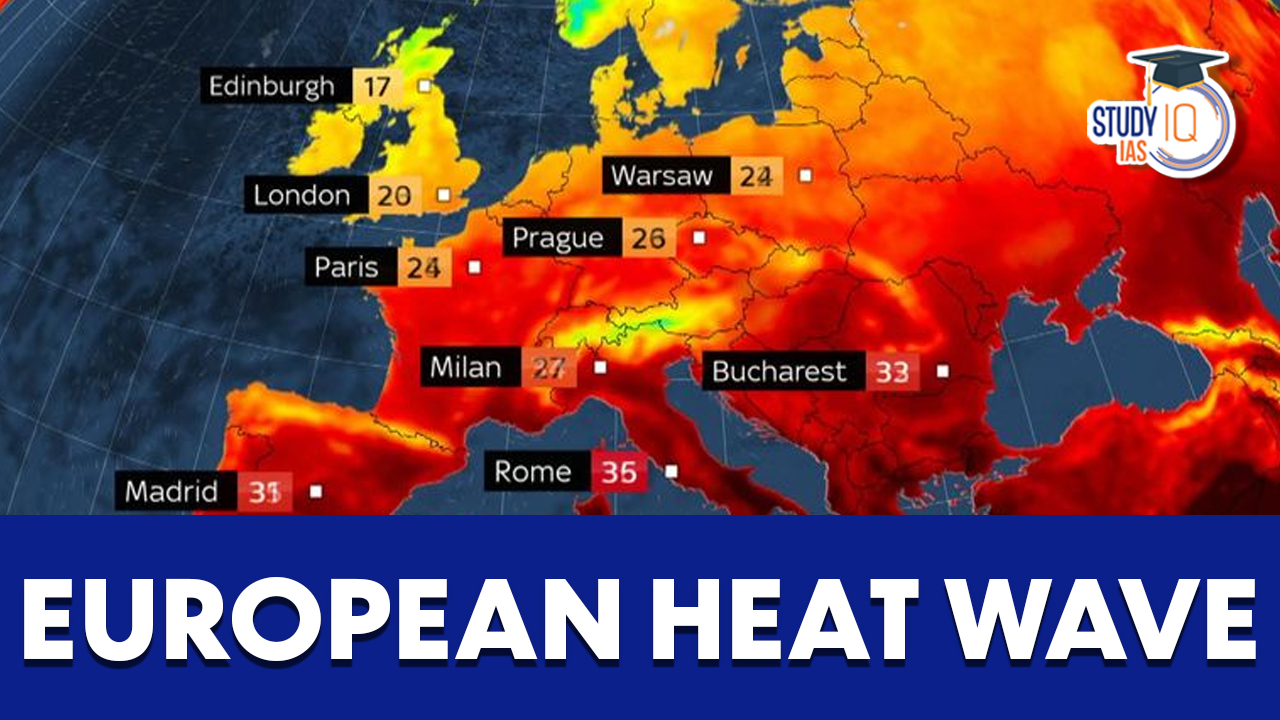Table of Contents
Context: Europe is currently grappling with a severe heatwave, prompting Italy to issue red alerts for several cities as temperatures are expected to break previous records.
What is causing heatwave in Europe?
- Anticyclonic conditions: The ongoing heatwave in Europe can be attributed to an anticyclone named Cerberus, which takes its name from the three-headed monster depicted in Dante’s Inferno.
- Anticyclones, or high-pressure systems, are weather patterns characterized by sinking air resulting in dry and stable conditions with minimal cloud cover and light winds.
- High-pressure systems lead to gentle winds and warm, dry weather as the descending air warms up. These systems tend to move slowly, persisting for several days or weeks.
- When an anticyclone forms over hot land areas like the Sahara, it intensifies the heat further by heating the existing warm air.
- Role of Climate Change: Rising global temperatures have caused shifts in atmospheric circulation patterns, leading to increased occurrences of extreme temperatures and droughts in Europe.
What are Heatwaves?
- Heat waves are extreme events in which hot temperature in summer months persist for a relatively long period of time.
- In India, heatwaves typically occur between March and June, and in some rare cases even extend till July.
- Criterion for declaring a heatwave in India (as per IMD):
| Heat wave is considered if maximum temperature of a station reaches at least 40°C or more for Plains and at least 30°C or more for Hilly regions. | |
| Based on Departure from Normal | Based on Actual Maximum Temperature |
|
|
| Note: If above criteria met at least in 2 stations in a Meteorological sub-division for at least two consecutive days, then the heatwave will be declared on the second day. | |
| Criterion for describing a heatwave in coastal stations: When maximum temperature departure is 4.50C or more from normal, Heat Wave may be described provided actual maximum temperature is 370C or more. | |
Causes of Heatwaves
- High-pressure systems: Heatwaves often occur when a high-pressure system becomes stationary over a region. High-pressure systems promote sinking air, which inhibits cloud formation and prevents the release of heat through convection. As a result, the air near the surface becomes trapped and warms up, leading to prolonged periods of high temperatures.
- Drought and lack of precipitation: When the soil is dry, more of the sun’s energy goes into heating the air rather than evaporating moisture from the ground. This leads to increased temperatures and further exacerbates the heatwave conditions.
- Role of global warming: The global warming is poised to make heat waves longer, more intense, and more frequent.
- The IPCC’s 6th Assessment Report projects that, for 1.5°C of global warming, there will be increasing heat waves, longer warm seasons and shorter cold seasons.
- The report also predicted that India will suffer more frequent and intense heat waves as well as increased precipitation in the remaining decades of the 21st century.
- Heatwaves have increased in frequency in recent decades due to global warming. 2022 was the fifth warmest for India since 1901.

- Urbanization: Rapid urbanization and the growth of concrete jungles in cities can lead to the phenomenon known as the “urban heat island effect.”
- Urban areas with high population density, buildings, and concrete surfaces absorb and retain more heat, leading to higher temperatures, particularly during heatwaves.
- El Nino Effect: During an El Nino event, the warming of the eastern Pacific Ocean can affect global weather patterns, causing changes in temperature, rainfall, and wind patterns around the world.
- The summer of the year 2023 is predicted to be excessively hot because of the earlier-than-expected occurrence of El Nino event.
Impacts of Heatwaves
- Agriculture and food production: Prolonged high temperatures can damage crops, reduce yields, and even lead to crop failures. Heat stress can also affect livestock, resulting in reduced productivity and increased mortality rates.
- In 2022, a heatwave in March curtailed India’s wheat production to 100 million tonnes against local consumption of 103.6 million tonnes.
- Human health: Heat-related illnesses like heatstroke, dehydration, and heat exhaustion can occur, and in severe cases, they can be fatal. The combination of high temperatures, increased air pollution, and heat-related illnesses can put a strain on healthcare systems.
- India saw a 55% increase in deaths due to extreme heat between 2000-2004 and 2017-2021, found the Lancet research.
- Natural ecosystems: Increased temperatures can lead to the degradation of habitats, changes in species distribution and behavior, and increased vulnerability to pests and diseases. Heatwaves can also contribute to the bleaching and death of coral reefs and affect marine ecosystems.
- During the summer of 2015-2016, a prolonged and intense heatwave in the Great Barrier Reef, off the coast of Australia, resulted in widespread coral mass bleaching.
- Infrastructure strain: Increased demand for air conditioning and cooling systems can overload power systems, leading to blackouts or power outages. Heat can also cause the expansion of materials, leading to road and pavement damage.
- Water resources: Higher temperatures increase evaporation rates, leading to the drying up of rivers, lakes, and reservoirs. This can have consequences for drinking water supplies, irrigation for agriculture, and aquatic ecosystems.
- Economic losses: The International Labour Organization (ILO) projects that economic losses related to heat stress will rise from US$280 billion in 1995 to $2.4 trillion in 2030, with lower-income countries seeing the biggest losses.
Heatwave Mitigation and Adaptation Strategies
- Climate change mitigation: The most effective way to avoid the negative impacts of heatwaves is to mitigate the climate change by reducing GHG emissions and minimize the rise in global mean temperatures.
- For example, shifts towards cleaner energies like solar energy, wind energy etc. will not only reduce GHG emissions, but will also reduce localized air pollution and heat island effects within the cities.
- Need to build resilience: A set of strategies to build resilience to extreme heat, “Resilience Strategies for Extreme Heat.” Some strategies include:
- Creating heat preparedness plans, identifying vulnerable populations, and opening cooling centers during extreme heat.
- Installing cool and green roofs and cool pavement to reduce the urban heat island effect.
- Planting trees to provide shade and to cool the air through evapotranspiration.
- Pursuing energy efficiency to reduce demand on the electricity grid, especially during heat waves.
- Heat Action Plans (HAPs): HAPs are India’s primary policy response to economically damaging and life-threatening heatwaves. They prescribe a variety of preparatory activities, disaster responses, and post-heatwave response measures across state, and districts to decrease the impact of heatwaves.
- Technological adaptations: Strengthening heat resilience and early-warning capabilities may yield disproportionate economic benefits.
- Contingent and temporary adaptations: Such as converting public spaces into cooling centers, deploying public evaporative cooling systems, and expanding emergency service availability.
- Urban greening: It was identified as key adaptation strategy with co-benefits that include emissions reductions, energy savings, better health outcomes, reduced urban heat island effect, and water savings.
- Community engagement and education: Engaging communities and promoting public education and awareness about heatwaves can encourage individuals to take preventive measures and adapt to changing climate conditions.


 UPSC EPFO Result 2025 Out: EO/AO and APF...
UPSC EPFO Result 2025 Out: EO/AO and APF...
 TNPSC Group 2 Main Exam List 2025 Releas...
TNPSC Group 2 Main Exam List 2025 Releas...
 TNPSC Group 2 Result 2025 Out: Check Mar...
TNPSC Group 2 Result 2025 Out: Check Mar...

























